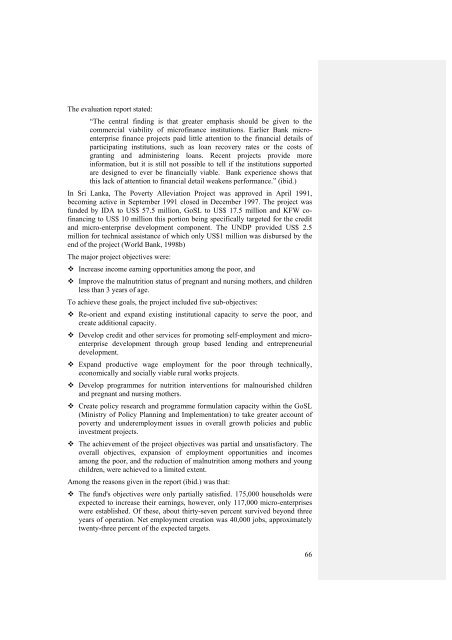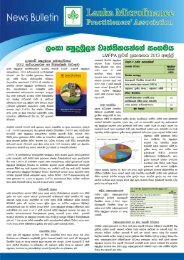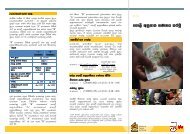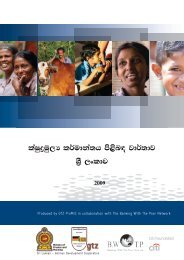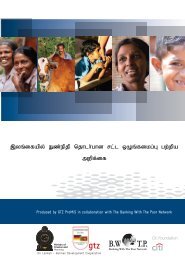National Microfinance Study of Sri Lanka: Survey of Practices and ...
National Microfinance Study of Sri Lanka: Survey of Practices and ...
National Microfinance Study of Sri Lanka: Survey of Practices and ...
You also want an ePaper? Increase the reach of your titles
YUMPU automatically turns print PDFs into web optimized ePapers that Google loves.
The evaluation report stated:<br />
“The central finding is that greater emphasis should be given to the<br />
commercial viability <strong>of</strong> micr<strong>of</strong>inance institutions. Earlier Bank microenterprise<br />
finance projects paid little attention to the financial details <strong>of</strong><br />
participating institutions, such as loan recovery rates or the costs <strong>of</strong><br />
granting <strong>and</strong> administering loans. Recent projects provide more<br />
information, but it is still not possible to tell if the institutions supported<br />
are designed to ever be financially viable. Bank experience shows that<br />
this lack <strong>of</strong> attention to financial detail weakens performance.” (ibid.)<br />
In <strong>Sri</strong> <strong>Lanka</strong>, The Poverty Alleviation Project was approved in April 1991,<br />
becoming active in September 1991 closed in December 1997. The project was<br />
funded by IDA to US$ 57.5 million, GoSL to US$ 17.5 million <strong>and</strong> KFW c<strong>of</strong>inancing<br />
to US$ 10 million this portion being specifically targeted for the credit<br />
<strong>and</strong> micro-enterprise development component. The UNDP provided US$ 2.5<br />
million for technical assistance <strong>of</strong> which only US$1 million was disbursed by the<br />
end <strong>of</strong> the project (World Bank, 1998b)<br />
The major project objectives were:<br />
Increase income earning opportunities among the poor, <strong>and</strong><br />
Improve the malnutrition status <strong>of</strong> pregnant <strong>and</strong> nursing mothers, <strong>and</strong> children<br />
less than 3 years <strong>of</strong> age.<br />
To achieve these goals, the project included five sub-objectives:<br />
Re-orient <strong>and</strong> exp<strong>and</strong> existing institutional capacity to serve the poor, <strong>and</strong><br />
create additional capacity.<br />
Develop credit <strong>and</strong> other services for promoting self-employment <strong>and</strong> microenterprise<br />
development through group based lending <strong>and</strong> entrepreneurial<br />
development.<br />
Exp<strong>and</strong> productive wage employment for the poor through technically,<br />
economically <strong>and</strong> socially viable rural works projects.<br />
Develop programmes for nutrition interventions for malnourished children<br />
<strong>and</strong> pregnant <strong>and</strong> nursing mothers.<br />
Create policy research <strong>and</strong> programme formulation capacity within the GoSL<br />
(Ministry <strong>of</strong> Policy Planning <strong>and</strong> Implementation) to take greater account <strong>of</strong><br />
poverty <strong>and</strong> underemployment issues in overall growth policies <strong>and</strong> public<br />
investment projects.<br />
The achievement <strong>of</strong> the project objectives was partial <strong>and</strong> unsatisfactory. The<br />
overall objectives, expansion <strong>of</strong> employment opportunities <strong>and</strong> incomes<br />
among the poor, <strong>and</strong> the reduction <strong>of</strong> malnutrition among mothers <strong>and</strong> young<br />
children, were achieved to a limited extent.<br />
Among the reasons given in the report (ibid.) was that:<br />
The fund's objectives were only partially satisfied. 175,000 households were<br />
expected to increase their earnings, however, only 117,000 micro-enterprises<br />
were established. Of these, about thirty-seven percent survived beyond three<br />
years <strong>of</strong> operation. Net employment creation was 40,000 jobs, approximately<br />
twenty-three percent <strong>of</strong> the expected targets.<br />
66


